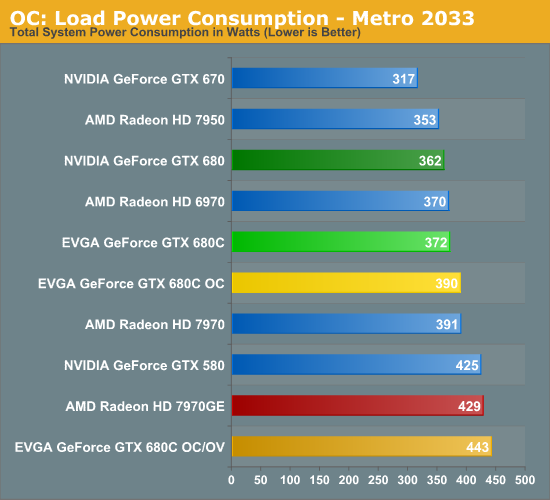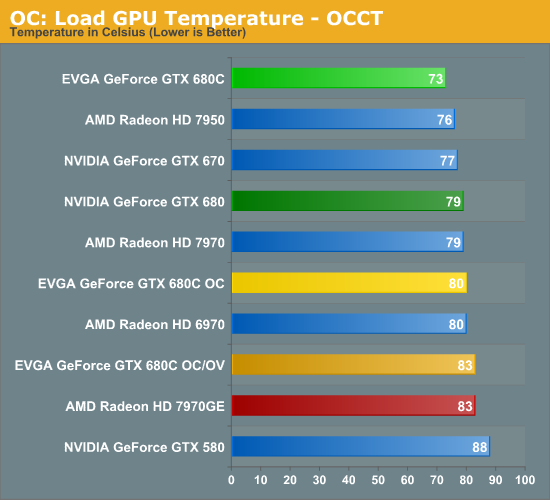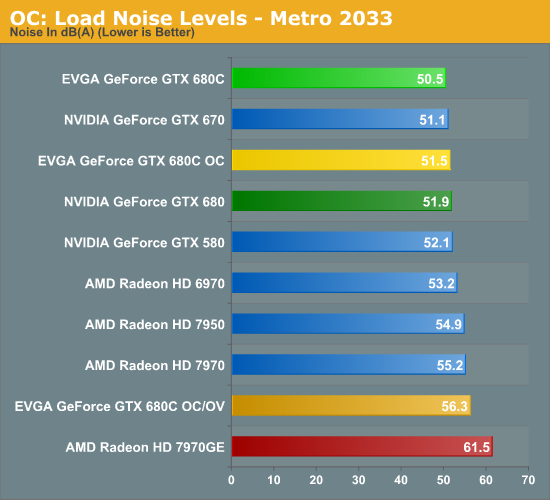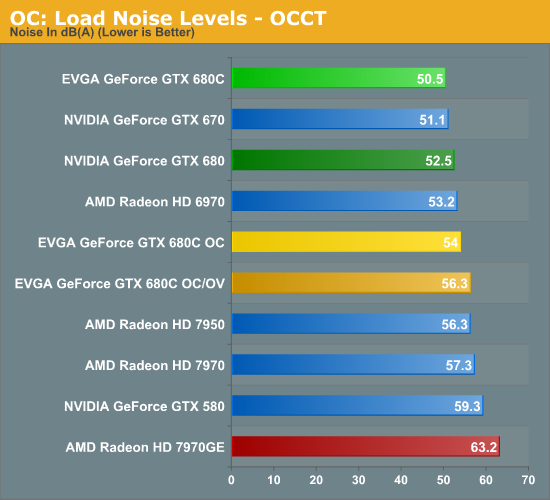EVGA GeForce GTX 680 Classified Review: Pushing GTX 680 To Its Peak
by Ryan Smith on July 20, 2012 12:00 PM ESTOverclocked: Power, Temperature, & Noise
So far our look at the stock performance of the GTX 680 Classified has been more obligatory than critical. The GTX 680 Classified is first and foremost an overclocking card, and while EVGA ships it with a decent factory overclock it’s the end-user overclock that is going to make the GTX 680 Classified stand apart from the crowd.
So how did the GTX 680 Classified fare? As always, we’re going to break our results down into two categories. We’ve overclocked our sample both with and without overvolting it, to get an idea of just how much more headroom is left in the GK104 GPU at stock, and how much more headroom is unlocked through overvolting.
| EVGA GTX 680 Classified Overclocking | |||||
| Stock | OC | OC + OV | |||
| Core Clock | 1111MHz | 1211MHz | 1287MHz | ||
| Max Boost Clock | 1201MHz | 1301MHz | 1377MHz | ||
| Memory Clock | 6GHz | 6.4GHz | 6.5GHz | ||
| Max Boost Voltage | 1.175v | 1.175v | 1.275v | ||
Without overvolting we were able to push our GTX 680 Classified an additional 100MHz(9%) on the core to 1211MHz. Given that we started with what was already a factory overclocked GPU, the fact that this is nearly 100Mhz beyond our next best card should come as no surprise. Binning doesn’t just isolate GPUs that can reach EVGA’s stock specifications, but it isolates those GPUs that can overclock better than the rest too.
Meanwhile on the memory front we were only able to push the memory a further 400MHz to 6.4GHz. This is noticeably less than what we’ve been able to push reference-based GTX 670/680 cards (which have reached nearly 7GHz), and it’s not immediately clear why we’re seeing this difference. With both a custom PCB and additional memory chips it’s possible that either one could be holding back memory overclocking, or more likely it’s a combination of the two. Regardless of the reason this does put the GTX 680 Classified in a bit of a bind, since the GTX 680 is no stranger to memory bandwidth starvation.
As for the impact of overvolting, unfortunately as it turns out overvolting didn’t greatly improve our results. With a core voltage of 1.275v (0.1v over stock) we were able to hit a base clock of 1286MHz, which is just 75MHz higher than what we hit on the stock voltage of 1.175v. In fact both in absolute and relative terms we gained more from our initial stock voltage overclock than we did from the overvolting overclock. Which is not to say that overvolting doesn’t help – clearly it does – but in our limited experience overvolting isn’t unlocking any kind of amazing clockspeed. It’s merely pushing GK104 a bit higher than it can go on stock voltage.
Memory overvolting doesn’t have a particularly great impact either. With a memory voltage of 1.65v we were able to squeeze out another 100MHz with the GTX 680 Classified’s 4GB of GDDR5. Much like the core overclock this is an improvement, but not greatly so.
Ultimately overvolting the GTX 680 Classified most certainly improves its overclockability, but at least on air you won’t be hitting any obscene clocks. Even then we don’t seem to be particularly temperature limited, so it’s not clear whether better (but not extreme) cooling would improve our overclocking results.
But before we jump into our results, there’s one more thing to take into consideration: that pesky power target. EVGA does have a higher power target, but even at 300W+ when using an increased power target, overvolting is going to quickly vault you towards it. The end result is that too much overvolting can make things slower, or at the very least limit the performance gains of what’s already a limited clockspeed increase.
The solution to this is EVGA’s BIOS switch, which effectively removes all of the power limits for the card, but this is not something to be used carelessly. Based on our temperature results with the stock BIOS there’s still some headroom, but the fact that this switch is labeled “LN2” is telling. Disabling all of the power limits is probably not a good idea on the reference cooler, at least in our conservative opinion.
So now that we’ve gone over overclocking in detail, what has it done for power temperature and noise? Let’s find out.


Starting as always with power consumption, as to be expected the impact of overclocking on power consumption varies wildly with whether we’re overvolting. Without overvolting our overclock pushes power consumption at the wall up by 18W in Metro, and a much more significant 49W with OCCT (though do keep in mind that we’ve also raised our power target to +132%). At least as far as games go, without a voltage increase the overall increase in power consumption is fairly small.
Pouring on the voltage significantly increases the power consumption however in both Metro and OCCT. With Metro our power consumption is now 443W at the wall, and with OCCT that’s 425W. This isn’t to say that the overvolting wasn’t worth it, but that additional 75MHz on the core clock and 100MHz memory clock has come with a significant cost.


As to be expected, load temperatures end up reflecting our power consumption figures. Without overvolting we see a 1C increase under Metro and a 7C increase under OCCT. Overvolting pushes the GTX 680 Classified over 80C in all circumstances, topping out at 83C with OCCT. At only 83C there’s still some thermal headroom to play with here for overclocking, but at 1.275v we’re approaching the safe & sane limits for GK104. Users looking to push the voltage harder will want better cooling, but even better cooling may not be enough in the long-run.


Finally we have our look at load noise. Without overvolting we see the overclocked GTX 680 Classified hit 51.5dB, which incredibly enough is still a smidge quieter than the reference GTX 680. For those of you looking for a fairly quiet overclocking card, the GTX 680 Classified is starting to look very good.
As for overvolting, in both Metro and OCCT cause our sample card to hit 56.3dB. This is understandably louder than the reference GTX 680 at this point, though in absolute terms whether it’s particularly loud or not depends on what you’re willing to put up with. The consolation prize here is that even with overclocking and overvolting it’s still 5dB+ quieter than the reference 7970GE.










75 Comments
View All Comments
Belard - Saturday, July 21, 2012 - link
This card is so old-school looking... like an Atari 2600... or 70s camera.ekon - Saturday, July 21, 2012 - link
Few people are aware that EVGA was in the compact camera business back in the 70s:http://tinypic.com/view.php?pic=65bac5&s=6
Belard - Saturday, July 21, 2012 - link
Wow, Amazing!Its so cool how a 1970s camera's lens look just like a blower! What were the chances!
:)
Belard - Sunday, July 22, 2012 - link
Kinda funny. I showed my 7yr old the big picture of this EVGA GTX 680 classified card and he said "it looked really old"... wow.For the retro- look, it does look nice. There will come a time when the computer toys we have today will look like OLD OLD junk.
If mankind makes it another 100 years, our PCs, tablets and GPUs would be like telegraph equipment.
CeriseCogburn - Tuesday, July 24, 2012 - link
That's an amazing comment considering the years long AMD standard block look on 99% plus AMD cards we've been treated to.I remember being sick to my stomache seeing the same old red red red red red pcb on them all. Finally one amd fan promoter claimed he had a blue pcb amd card and linked a pic but it has the same old sad red square cover with the black lines.
I do realize when the amd double D breast design recently hit many fanboys went into some sort of sexually perverse mental mode, but that shouldn't wipe out the endless years of amd standard fare we were all tortured with.
In the case of this card, there's a lot of white on the outside I haven't seen anywhere else, the white "top" with printing will be staring at you out of the case, something so many cards have been oblivious too for far too long... then we also have the black carbon look - another unusual feature although with the fanboysim over anything and everything black that is understandable as I'm sure their pr boys figured that part a clear win, sadly enough.
Haravikk - Saturday, July 21, 2012 - link
With 4gb RAM it seems like it's almost intended to be the ultimate Second Life card; powerful enough to handle that app's mediocre but insanely demanding graphics with the RAM to hold all the hundreds of overly high-resolution textures plastered onto every visible surface.But for $660 I'm not sure it's worth the novelly =)
dave1_nyc - Saturday, July 21, 2012 - link
OK, I know that this is trivial, but the previous Classified at least looked kinda cool and unique. This one seems visually unappealing.CeriseCogburn - Tuesday, July 24, 2012 - link
But once you put it in the case, usually within a few minutes of having an insane "unboxing" session much like a religious pilgrimage with a possible absolutely boring youtube minutes somehow considered a "treat" by the disturbed (of which there are many), you shove it in the case and put on the side cover... never to really see it ever again in it's fully glory, until it's death.What you will see is the big fat WHITE laberl and red classified printing jamming at your face if you have a side window..... clearly the most important aspect - even though 98% don't have a window to look through... but if you do - you're set.
Don't mind me - I'm still amazed how "the feel" of some look makes it or breaks it for 99% of the retarded humans that surround me - especially when "the looking" is done like .000001% of the time as in the case of these video cards.
It must have to do with their estrogen levels I tell myself, or maybe they don't have a girlfriend and that's why...
MrSpadge - Saturday, July 21, 2012 - link
> Software overvoltage control is forbidden.I can understand this for the reference design. But for custom designs? WTF?!
shin0bi272 - Sunday, July 22, 2012 - link
The instant I saw the original 680 I said that the 256bit memory bus was going to limit it severely. Even before I saw any other stats for the thing I knew id never buy one. Nvidia was cheap when they released the 680 because they saw what the 7970 was putting out and they said we'll call our 660 midrange our 680 high end and we can make more money (also love the fact that you guys test the handful of games that amd's 7 series beats the nvidia 6 series... not cherry picking your benchmarks at all nooo).This card does push the 680 to its limit which is cool and all but it just proves that a) the 256bit mem bus is still a midrange card designator no matter how much they claim gddr5 is fast enough to not need more than that... it does. And b) Nvidia could have pushed the 680's base clock up much higher and, while it would still be bottle necked bad, it would have been more attractive.
Bring on the 700 series Im done with the 6's